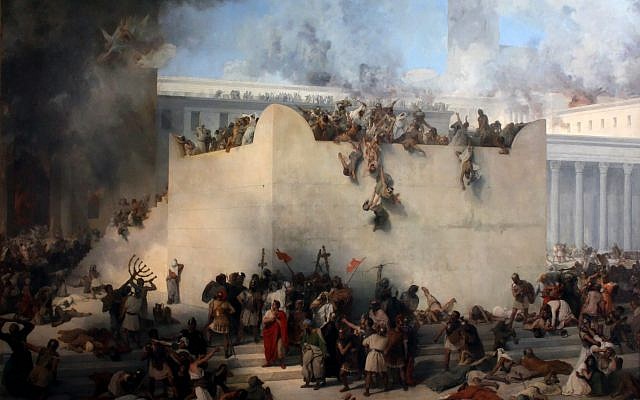Recalling Our Two Temples of Old
There was a time in the 1940s and 1950s when Tisha B’Av was almost unknown.
Rabbi David Geffen is a native Atlantan and Conservative rabbi who lives in Jerusalem.
There was a time in the 1940s and 1950s when Tisha B’Av was almost unknown. I recall going to Congregation Shearith Israel the night of Tisha B’Av where I was the youngest by far. Mr. Abe Edelstein (z’’l), actually a first cousin of Rabbi Tobias Geffen via Shayne Schaffer Edelstein, read the Book of Lamentations, Eichah, with fervor. No one sat on the floor; the lights were not turned off so you could read by flashlight. This is 1946 and 1947 before Israel became a state. My grandfather stayed up all night with his own tikkun reading and reciting the kinot (elegies) in his study at the Geffen home, 593 Washington Street, Atlanta. Once I visited him during the night. I can still recall his emotion as he truly mourned the destruction of both Temples.
Factually, the first recorded observance of Tisha B’Av in our state was held in Savannah. Rabbi Saul Rubin, the historian of Savannah Jewry, wrote. “Mikve Israel’s building committee met in 1840 in early July to select a date for detailing the dedication of the new building. July 21, 1820, was selected – the day after Tisha B’Av.”
Rubin described the fast day services, just a simple reading of Lamentations. However, it was most meaningful because the next day everyone knew the building, where they observed Tisha B’Av, would be dedicated. “This was a time of hope and elevation in their lives,” Rubin wrote.
There is historical data which proves why Tisha B’Av had to be observed. The first Temple in Jerusalem was destroyed by the Babylonians on the ninth of Av in 586 B.C.E. The Second Temple was destroyed by the Romans on the ninth of Av 70 C.E. Traditions to buttress the observance are frequently cited. When Jews rebelled against the Romans, they were defeated at Beitar, a major fortress, in the third century C.E., on the ninth of Av. Citing another sad event on the day, the ninth of Av 1196 C.E. marked the expulsion of the Jews from England. On Tisha B’Av in 1492, Jews were expelled from Spain after the Inquisition. World War I began on Tisha B’Av in 1914. The destruction of the Jews in the Holocaust began in Poland in 1938 on that ominous fast day.
Tisha B’Av falls in the summer when people are on vacation, sometimes even the rabbi of a congregation. Rabbis have faced the necessity of keeping the meaning of Tisha B’Av alive by returning from their vacation to lead the fast day services. They are ensuring its sadness and mourning remain significant.
The great revival of Tisha B’Av in the USA began when the summer camps, from Reform to Labor Zionist, from Camp Ramah to Camp Massad, later Morasha, and Camp Tel Yehudah (Young Judaea) to the famous Camp Cejwin, focused on the day, the ninth of Av.
My fellow attendees and counselors at Camp Blue Star were “overwhelmed” by the manner in which Uncle Harry (z”l) and Uncle Herman (z”l), the Popkin brothers, planned the observance, so well and in such a moving fashion we can never forget it.
On erev Tisha B’Av at Blue Star in the 1950s, as the shadows were turning into darkness, every camper and counselor who had brought whites to camp, dressed in them. Each of the bunks in a unit flowed down toward the lake. When we reached a certain point in our descent, we were each handed a lit candle. The music counselor had sessions the week before to instruct us in the hymn from the Psalms, “al naharot bavel, by the shores of Babylonia we wept.” Imagine the air of the camp filled with this melody, producing a moving moment.
As we neared the lakefront, we saw across the lake six giant torches burning, a very early reference to the destruction of the 6 million. This occurred because the Popkin brothers had been working secretly during World War II to try to save some Jews. They were relentless in their efforts.
As we reached the shore, with several hundred candles burning, we could see that on the lake there was some kind of boat. We could barely make out the people on the boat and what they were holding. From the other side of the lake, the sound boxes carried the well-known words “Eli, Eli.” (My Lord, My God) Those who knew the words sang too. Someone read the passages in Hebrew and English from the Tanach-Bible about the actual destruction of First Temple. Did we cry? Not sure.
Next, on the boat torches were lit and you could see a large model of the Temple in plywood. The torches touched that miniature structure, and the flames rose, incinerating that moving reminder of our past. A few passages from the Book of Lamentations were chanted, I think, by a waiter, David Their, whose voice was magnificent. Many of us did begin to whisper, “our Temple had been destroyed.” To bolster our faith, “’Ani Ma’amin,’ I believe,” surged forth from all of us.
I observed Tisha B’Av at Camp Daniel Morgan, at Camp Rutledge, at Camp Blue Star and at Camp B’nai B’rith. Each year it was different, but Blue Star was the most powerful of all. The Popkin brothers, both professional Jewish leaders in AZA and Young Judaea, chose to make Tisha B’Av a highlight of the camping season, which would bolster our Judaism in the years to come. Even if campers had never heard about the day, the fast of Tisha B’Av, they found its presentation on a lake in Hendersonville, N.C., locale of the camp, a most moving experience.
Rabbi David Geffen is a native Atlantan and Conservative rabbi who lives in Jerusalem.




comments